Reminiscing
 In a long-standing Western European tradition, the bees must be told of important events in the lives of their owners. Things such as deaths, births, marriages, and departures and returns in the keeper’s household. It is believed that the bees need to go through a mourning process to keep them emotionally healthy. If this practice was omitted or forgotten, and the bees were not “put into mourning,” then it was believed a penalty would be paid, such as the bees leaving their hive, stopping the production of honey, or even dying. Such a thing seems strange to anyone who has never had anything to do with bees, but who knows. Maybe they know, just like a dog or a cat knows their owner is gone. Best known in England, the practice has also been recorded in Ireland, Wales, Germany, Netherlands, France, Switzerland, Bohemia (now Czechia) and the United States.
In a long-standing Western European tradition, the bees must be told of important events in the lives of their owners. Things such as deaths, births, marriages, and departures and returns in the keeper’s household. It is believed that the bees need to go through a mourning process to keep them emotionally healthy. If this practice was omitted or forgotten, and the bees were not “put into mourning,” then it was believed a penalty would be paid, such as the bees leaving their hive, stopping the production of honey, or even dying. Such a thing seems strange to anyone who has never had anything to do with bees, but who knows. Maybe they know, just like a dog or a cat knows their owner is gone. Best known in England, the practice has also been recorded in Ireland, Wales, Germany, Netherlands, France, Switzerland, Bohemia (now Czechia) and the United States.
It is unknown how this practice got started, or where it stared exactly, but unfounded speculation has it that it 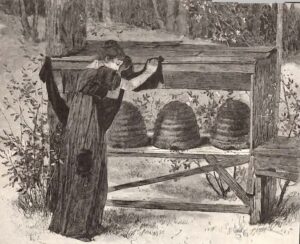 is loosely derived from or perhaps inspired by ancient Aegean notions about bees’ ability to bridge the natural world and the afterlife. There were many notions that people of ancient times believed, so I suppose this could be one of them.
is loosely derived from or perhaps inspired by ancient Aegean notions about bees’ ability to bridge the natural world and the afterlife. There were many notions that people of ancient times believed, so I suppose this could be one of them.
The whole practice has a number of strange parts to it and probably came from superstition. Apparently, it is tradition to give a piece of wedding cake or a funeral biscuit to the bees at wedding and funerals. This is done to inform the bees at the same time of the name of the party married or dead. Apparently, if the bees do not know about the marriage, they become very irate, and sting everybody within their reach. If they are ignorant of the death, they become sick, and many of them die. That might possibly speak to something similar to a pet losing its master. In the case of a death, it would inform them of a new owner. Again, this reminds me of a pet mourning an owner, even when they are shown love by the new owner. Animals can show love, maybe bees can too.

The practice even extends to the royal family. After the passing of Britain’s Queen Elizabeth II in 2022, the Royal Beekeeper, John Chapple, went out to inform the bees of Buckingham Palace and Clarence House of her passing and the accession of King Charles III. There is a proper process for informing the bees. According to Chapple, “You knock on each hive and say, “The mistress is dead, but don’t you go. Your master will be a good master to you.” Often the hive is also given a black sash for mourning. The purpose of all this is to ensure the health of the bees and the continuation of their honey production. It’s a strange, but interesting tradition.
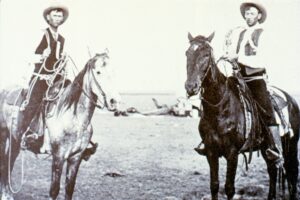 As the ranchers opened up the American West, they became some of America’s elite citizens. Their ranches soon became the target of criminals looking to make easy money. Of course, the ranchers had more than just their reputations…they had money and influence, and when their cattle started going missing, they were going to have their revenge. Cattle rustling was considered a serious offense in the American West and, in some cases, resulted in vigilantes hanging or shooting the thieves. Tempers always ran hot when these criminals were caught. While the ranchers were rich, they still worked just as hard for their money as anyone else.
As the ranchers opened up the American West, they became some of America’s elite citizens. Their ranches soon became the target of criminals looking to make easy money. Of course, the ranchers had more than just their reputations…they had money and influence, and when their cattle started going missing, they were going to have their revenge. Cattle rustling was considered a serious offense in the American West and, in some cases, resulted in vigilantes hanging or shooting the thieves. Tempers always ran hot when these criminals were caught. While the ranchers were rich, they still worked just as hard for their money as anyone else.
During the Civil War, Mexican cattle rustlers were a major issue. As with crimes across our southern border today, the Mexican government was accused of supporting the habit of cattle rustling. Of course, Mexican rustlers weren’t alone in their crimes. American rustlers also stole Mexican cattle from across the border, and 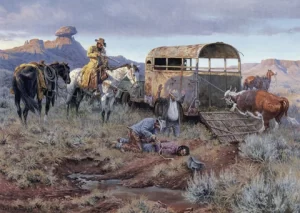 the reality is that not every rustler was from Mexico. The United States had its share of thieves too. One prime target was unbranded new calves. When ranchers failed to brand new calves, it facilitated theft. Unbranded calves were very hard to track, and their theft was difficult to prove. Of course, cattle could be stolen out of necessity, or by the Indians, but while that is technically rustling, it could be looked at somewhat differently. Not that it really ever was. Cattle rustling was cattle rustling, and that was all there was to it.
the reality is that not every rustler was from Mexico. The United States had its share of thieves too. One prime target was unbranded new calves. When ranchers failed to brand new calves, it facilitated theft. Unbranded calves were very hard to track, and their theft was difficult to prove. Of course, cattle could be stolen out of necessity, or by the Indians, but while that is technically rustling, it could be looked at somewhat differently. Not that it really ever was. Cattle rustling was cattle rustling, and that was all there was to it.
Conflict over alleged rustling was a major issue in the Johnson County War of 1892 in Wyoming. The conflict began when cattle companies began persecuting alleged rustlers in the area, many of whom were settlers who competed with them for livestock, land, and water rights. As the violence swelled between the large established ranchers and the smaller settlers in the state, it culminated in the Powder River Country, when the ranchers decided to hire gunmen to invade the county. This was the beginning of vigilantes when it came to cattle rustling. They were ruthless, and they spared no one who was thought to be a rustler.
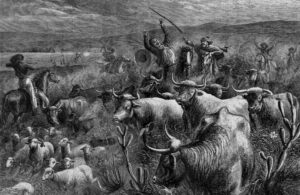
When the ranchers transitioned from open range to fenced grazing, cattle rustling gradually declined in North America. In the 20th century, A different kind of rustling emerged…often called suburban rustling, the practice involved rustlers anesthetizing the cattle and then taking them directly to auction. This eliminated the need to storing the cattle. The practice usually takes place at night, which makes detection difficult for law enforcement. On large ranches, it can take several days for the loss of cattle to be noticed and reported. for that reason, convictions are extremely rare, and even nonexistent.

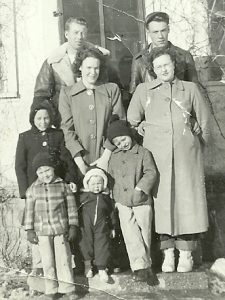 A couple of days ago, we found out that our aunt, Esther Hein had passed away. She was 84 years old. Esther was the eldest of my husband, Bob’s grandmother’s children from her second marriage. I am so sorry to see her go. With her passing, all of Grandma’s children are gone. It is now left to the grandchildren to carry on the legacy Grandma started. Esther had lived much of her adult life in California and Oregon, choosing that milder climate over the harsh Montana winters. Because of where they lived, we didn’t see Esther’s family very often, but she did her best to come for visits to see her parents, Walt and Vina Hein, and siblings Marion Kanta, Walt Schulenberg, Eddie Hein, and Butch Hein and their families in Montana and Wyoming as often as she could manage.
A couple of days ago, we found out that our aunt, Esther Hein had passed away. She was 84 years old. Esther was the eldest of my husband, Bob’s grandmother’s children from her second marriage. I am so sorry to see her go. With her passing, all of Grandma’s children are gone. It is now left to the grandchildren to carry on the legacy Grandma started. Esther had lived much of her adult life in California and Oregon, choosing that milder climate over the harsh Montana winters. Because of where they lived, we didn’t see Esther’s family very often, but she did her best to come for visits to see her parents, Walt and Vina Hein, and siblings Marion Kanta, Walt Schulenberg, Eddie Hein, and Butch Hein and their families in Montana and Wyoming as often as she could manage.
It was on one of her trips to visit her parents, that I first met Esther. It was a good meeting for me, because when I married into the family, my husband Bob asked me to just cut his hair for him. Well, that was a really bad plan. I had never cut a guy’s hair, and it looked awful. His mother had to try to fix it. Ugh!! While we were visiting Grandma and Grandpa, Bob decided to ask Esther to cut his hair. She was trained to do that, so it was a 
 good plan. Esther took pity on me, and she taught me how to cut Bob’s hair. It is a skill that has served me well over the last 50 years, and one for which I will always be thankful to Esther for…as will Bob.
good plan. Esther took pity on me, and she taught me how to cut Bob’s hair. It is a skill that has served me well over the last 50 years, and one for which I will always be thankful to Esther for…as will Bob.
Esther was as skilled seamstress and artist. I remember a set of bathroom curtains she made for my mother-in-law, (her sister-in-law) Joann Schulenberg. She loved them and in her later years, while I was taking care of her when she had Alzheimer’s Disease, she never forgot to tell me about the beautiful curtains that Esther had made for her. My mother-in-law loved Esther dearly. When they were first married, my mother-in-law and father-in-law, Walt Schulenberg often kept Esther at their house in town during the harsh Montana winters, so she wouldn’t miss school, because they couldn’t always get her to town from the ranch. Esther was almost like their own daughter, except that they were too young to have a daughter her age at the time. Esther never forgot how special they were to her, and when she started painting, she painted a landscape picture on a saw 
 blade for her brother, Walt. He cherished it always. She also painted a set of TV trays for him, one of which I have now. Her work was beautiful. While she couldn’t come for visits anymore, she loved keeping in touch with the family, and spoke to my sister-in-law, Debbie Cook on a regular basis. They were very close. My sister-in-law, Brenda Schulenberg also kept her updated by printing out and mailing her many of the family stories from my blog. Esther loved reading all about the younger generation as they grew up. Esther was a beautiful soul, and we are going to miss her very much.
blade for her brother, Walt. He cherished it always. She also painted a set of TV trays for him, one of which I have now. Her work was beautiful. While she couldn’t come for visits anymore, she loved keeping in touch with the family, and spoke to my sister-in-law, Debbie Cook on a regular basis. They were very close. My sister-in-law, Brenda Schulenberg also kept her updated by printing out and mailing her many of the family stories from my blog. Esther loved reading all about the younger generation as they grew up. Esther was a beautiful soul, and we are going to miss her very much.

 My niece, Amanda Reed is one of the most active people I know. She has sports and activities for every season and looks forward excitedly for each new season’s arrival. Amanda’s friends and family make up her circle of influence, and they are a group of people she can count on to be there through thick and thin. In addition, Amanda’s partner, Sean Mortensen and their daughter Jadyn are her very life. These days, Jadyn spends much of her time in Laramie attending the University of Wyoming. It was a big change for Amanda and Sean, but they are very proud of their girl, and very happy for her.
My niece, Amanda Reed is one of the most active people I know. She has sports and activities for every season and looks forward excitedly for each new season’s arrival. Amanda’s friends and family make up her circle of influence, and they are a group of people she can count on to be there through thick and thin. In addition, Amanda’s partner, Sean Mortensen and their daughter Jadyn are her very life. These days, Jadyn spends much of her time in Laramie attending the University of Wyoming. It was a big change for Amanda and Sean, but they are very proud of their girl, and very happy for her.
Amanda is in the middle of a long career in banking. She began her career when she went to work at the 
 Rawlins National Bank at a young age. Since that time, she has worked her way up to the pretty prestigious position of BSA Agent, which is a part of the law enforcement area of the bank. It is strange to think of Amanda in “law enforcement” and while it isn’t the normal type, it is law enforcement, nevertheless. Her work is in deterring fraud, money laundering, and such. I don’t claim to know all she does, but I know that it is an important part of the banking system. Counterfeit money and other types of fraud cost everyone in the end, Amanda works to stop this, and that is good for everyone.
Rawlins National Bank at a young age. Since that time, she has worked her way up to the pretty prestigious position of BSA Agent, which is a part of the law enforcement area of the bank. It is strange to think of Amanda in “law enforcement” and while it isn’t the normal type, it is law enforcement, nevertheless. Her work is in deterring fraud, money laundering, and such. I don’t claim to know all she does, but I know that it is an important part of the banking system. Counterfeit money and other types of fraud cost everyone in the end, Amanda works to stop this, and that is good for everyone.
As Summer approaches, I’m sure Amanda and her “gang” will be gearing up for the next season of great 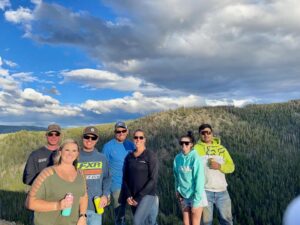
 weekend fun. They love boating, skiing, jet skis, fishing, and hanging out with great friends. While Winter is great for snow sports, they look forward to summer fun too. When these guys get together, they know it’s going to be a great time. These friends have been friends for a long time, and they all have similar likes. There is never a dull moment. Amanda is very blessed with the people she surrounds herself with. Today is Amanda’s birthday. Happy birthday Amanda!! Have a great day!! We love you!!
weekend fun. They love boating, skiing, jet skis, fishing, and hanging out with great friends. While Winter is great for snow sports, they look forward to summer fun too. When these guys get together, they know it’s going to be a great time. These friends have been friends for a long time, and they all have similar likes. There is never a dull moment. Amanda is very blessed with the people she surrounds herself with. Today is Amanda’s birthday. Happy birthday Amanda!! Have a great day!! We love you!!
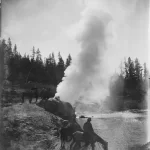
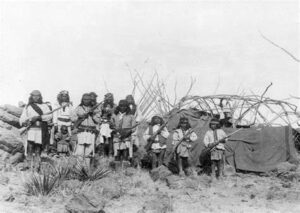 The Indians, at least the ones present in the early days of the United States, were very superstitious, and they believed that the hissing and thundering of the geysers to be voices of evil spirits. Not knowing much about the curvature of the Earth, they also regarded the mountains at the head of the river as the crest of the world. They believed that if they could make it over the summits, they would gain the happy hunting-grounds below. They believed their homes would be blessed. The Indians loved this land and felt like it was the land left to them by their fathers, who had hunted there. They didn’t want to hand it over to the white man. Nevertheless, the soldiers were duty bound to pursue the defiant warriors, to avenge the wrongs the Indians had committed while suffering under the sting of tyranny and wrong. It had been a bloody battle and just scant few of the fugitive band finally gathered at the head of the canyon known as the Grand Canyon of the Yellowstone. These few had succeeded in escaping the bullets of the soldiers, and they had courageously decided to die rather than be taken and carried away to be placed in a distant prison. This was their homeland, and they would die rather than leave it again.
The Indians, at least the ones present in the early days of the United States, were very superstitious, and they believed that the hissing and thundering of the geysers to be voices of evil spirits. Not knowing much about the curvature of the Earth, they also regarded the mountains at the head of the river as the crest of the world. They believed that if they could make it over the summits, they would gain the happy hunting-grounds below. They believed their homes would be blessed. The Indians loved this land and felt like it was the land left to them by their fathers, who had hunted there. They didn’t want to hand it over to the white man. Nevertheless, the soldiers were duty bound to pursue the defiant warriors, to avenge the wrongs the Indians had committed while suffering under the sting of tyranny and wrong. It had been a bloody battle and just scant few of the fugitive band finally gathered at the head of the canyon known as the Grand Canyon of the Yellowstone. These few had succeeded in escaping the bullets of the soldiers, and they had courageously decided to die rather than be taken and carried away to be placed in a distant prison. This was their homeland, and they would die rather than leave it again.
The brave warriors built a raft and tied it securely on the river at the foot of the upper falls. Then they reveled, for a few days, in the peace and the bounty of the area that had always belonged to them, feeling once again that it belonged to them and that maybe there was no such thing as the white men who were pursuing them relentlessly. Their time in that beautiful place was, however, short-lived, and one morning, they are aroused from peaceful sleep by the crack of rifles fire. The soldiers had found them.
With resolve, and knowing that they could not escape, the warriors boarded their raft and pushed out toward the middle of the stream. I don’t know if they were trying for the opposite shore, or if they knew what would happen next, but the current immediately grabbed the raft and held it firmly in its grasp. Some of the warriors had guns that they defiantly discharged at the soldiers. For their part, the soldiers just stood in shock as the scene unfolded in front of their horrified eyes. The soldiers didn’t even fire a single shot, but instead, watched with nothing short of dread as the raft passed into the current and was wildly tossed around, whirling faster and faster. The waves seemed to sing a “death song” as they triumphantly forced the raft closer and closer to the edge and the roar of the falls. It is hard to say if the warriors felt and fear, or if they had simply decided that death was preferred to a life in prison. Whatever they felt, was drowned as the faced the soldiers with a look of defiance, and screamed the tones of the death chant, of no less than hate and even celebration, lurched onward to their end.
In times of war, the two sides are prepared to kill, but as the raft raced toward the edge, the soldiers, as 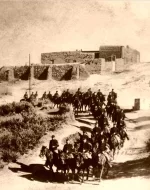
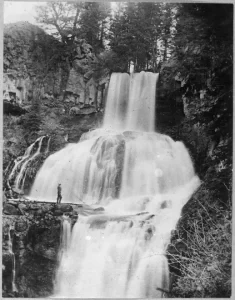 hardened as they were, could not stop their shudders as they contemplated the fate the Indians had chosen for themselves. Then, the brink was reached. The raft was pulled between the jaws of the rocks at the top of the falls. Beyond the rocks were vast walls, leading to the floor of the gulf a thousand feet below. The raft tipped toward the gulf, and with a cry of triumph, the Indians were launched over the edge into the raging falls. As the warriors fell, they were met by the brilliant colors of the rising sun. The view would have normally been considered beautiful and even peaceful, except for the horror of what was coming. Nevertheless, the warriors had decided that they would rather die than leave the land they loved, and so they died…on their own terms.
hardened as they were, could not stop their shudders as they contemplated the fate the Indians had chosen for themselves. Then, the brink was reached. The raft was pulled between the jaws of the rocks at the top of the falls. Beyond the rocks were vast walls, leading to the floor of the gulf a thousand feet below. The raft tipped toward the gulf, and with a cry of triumph, the Indians were launched over the edge into the raging falls. As the warriors fell, they were met by the brilliant colors of the rising sun. The view would have normally been considered beautiful and even peaceful, except for the horror of what was coming. Nevertheless, the warriors had decided that they would rather die than leave the land they loved, and so they died…on their own terms.
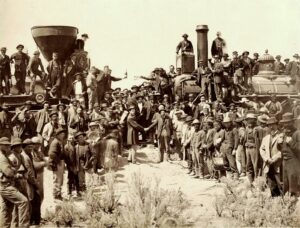 I have taken a number of train rides in my life. I love riding the trains. Some rides were very comfortable, while others are more primitive, with wooden seats, that would not be suitable for a long trip. The transcontinental train was not technically a part of the Gilded Age, when everything was luxurious, but it did feature many of the trapping of that era, and not just in the parlors of the Gilded Age magnates, but in the cars where the everyday travelers would ride too…at least in the first class cars. The cars were adorned with velvet seat cushions and gilt-framed mirrors, and the passengers feasted on antelope, trout, berries, and even champagne. Of course, not every train in 1869 was so elaborately adorned, but then the others were not the Transcontinental Train either. Still, the second-class passengers did have upholstered seats, making their trip not too bad. The third-class, or “emigrant” passengers, paid half of what the first-class passengers did, but they had to sit on benches instead of seats and bring their own food.
I have taken a number of train rides in my life. I love riding the trains. Some rides were very comfortable, while others are more primitive, with wooden seats, that would not be suitable for a long trip. The transcontinental train was not technically a part of the Gilded Age, when everything was luxurious, but it did feature many of the trapping of that era, and not just in the parlors of the Gilded Age magnates, but in the cars where the everyday travelers would ride too…at least in the first class cars. The cars were adorned with velvet seat cushions and gilt-framed mirrors, and the passengers feasted on antelope, trout, berries, and even champagne. Of course, not every train in 1869 was so elaborately adorned, but then the others were not the Transcontinental Train either. Still, the second-class passengers did have upholstered seats, making their trip not too bad. The third-class, or “emigrant” passengers, paid half of what the first-class passengers did, but they had to sit on benches instead of seats and bring their own food.
With the move west, thousands of people flocked to the Transcontinental Railroad beginning in 1869. The 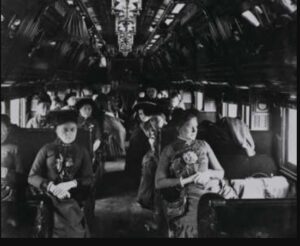 railroad, which stretched nearly 2,000 miles between Iowa, Nebraska, and California, reduced travel time across the West from about six months by wagon or 25 days by stagecoach to just four days. That was an amazing change, and it meant that families that moved west might actually be able to see loved ones they left behind. Prior to that time, moving west could mean saying goodbye forever to the family members who stayed behind. The Transcontinental Railroad represented both the height of modern technology and the tempting possibility of unrestricted travel, although it might take time for people to feel safe with train travel.
railroad, which stretched nearly 2,000 miles between Iowa, Nebraska, and California, reduced travel time across the West from about six months by wagon or 25 days by stagecoach to just four days. That was an amazing change, and it meant that families that moved west might actually be able to see loved ones they left behind. Prior to that time, moving west could mean saying goodbye forever to the family members who stayed behind. The Transcontinental Railroad represented both the height of modern technology and the tempting possibility of unrestricted travel, although it might take time for people to feel safe with train travel.
While the train made it possible to go west much quicker, it wasn’t cheap, nor was it as fast as future forms of travel would be. The first passenger train on the line took 102 hours to travel from Omaha, Nebraska to San Francisco, California, and a first-class ticket cost $134.50, which is about $2,700 today…hardly affordable for a 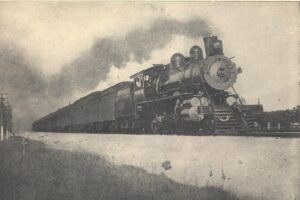 casual trip. Families might save for years to be able to visit their child, and often only one family member could go at a time. The places the train traveled, were not filled with cities, towns, or even very many homesteads, because at the time, the areas through which the train had been built were not yet open to large numbers of white settlers. In fact, millions of acres of the land the new railroad traversed had belonged to the Native American people, but the US Congress had granted the land to railroad companies. The Native Americans saw this as an intrusion, knowing that behind it would come a wave of white settlers. Nevertheless, the trains and the white man were here to stay.
casual trip. Families might save for years to be able to visit their child, and often only one family member could go at a time. The places the train traveled, were not filled with cities, towns, or even very many homesteads, because at the time, the areas through which the train had been built were not yet open to large numbers of white settlers. In fact, millions of acres of the land the new railroad traversed had belonged to the Native American people, but the US Congress had granted the land to railroad companies. The Native Americans saw this as an intrusion, knowing that behind it would come a wave of white settlers. Nevertheless, the trains and the white man were here to stay.
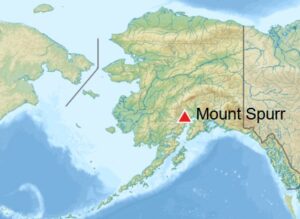
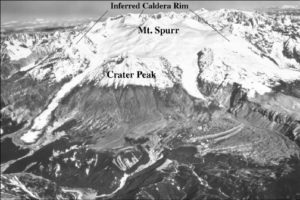 Recently, in a Mount Saint Helens-esk alert level increase, Mount Spurr, a stratovolcano in the Aleutian Arc of Alaska, made its entrance into the spotlight. The volcano isn’t about to explode in the same way Mount Saint Helens was, but it does appear to be about to erupt again. Mount Spurr was named after United States Geological Survey geologist and explorer Josiah Edward Spurr, who led an expedition to the area in 1898. Mount Spurr is currently rated at a Level of Concern Color Code Yellow by the Alaska Volcano Observatory (AVO). It’s obvious that Mount Spurr has an active history, because it is aboriginally known by the Dena’ina Athabascan name K’idazq’eni, which literally means “that which is burning inside.”
Recently, in a Mount Saint Helens-esk alert level increase, Mount Spurr, a stratovolcano in the Aleutian Arc of Alaska, made its entrance into the spotlight. The volcano isn’t about to explode in the same way Mount Saint Helens was, but it does appear to be about to erupt again. Mount Spurr was named after United States Geological Survey geologist and explorer Josiah Edward Spurr, who led an expedition to the area in 1898. Mount Spurr is currently rated at a Level of Concern Color Code Yellow by the Alaska Volcano Observatory (AVO). It’s obvious that Mount Spurr has an active history, because it is aboriginally known by the Dena’ina Athabascan name K’idazq’eni, which literally means “that which is burning inside.”
Located 81 miles west of Anchorage and northeast of Chakachamna Lake, Mount Spurr is the highest volcano of the Aleutian Arc. It has a large stratocone at the center of a roughly 3.1 miles horseshoe-shaped caldera that is open to the south. The caldera was formed by a Mount Saint Heles like “late-Pleistocene or early Holocene sector collapse and associated pyroclastic flows that destroyed an ancestral Spurr volcano. The debris avalanche traveled more than 15.5 miles to the southeast, and the resulting deposit contains blocks as large as 330 feet in diameter. Several ice-carved post-caldera domes lie in the caldera.” The present-day Mount Spurr is 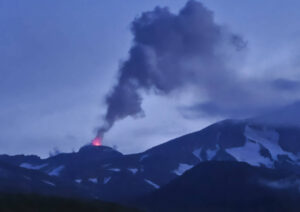 the highest of the post-caldera. So much change can take place as the events of a volcano unfold. The regrown summit peak of Mount Spurr experienced a heating event in 2004 which created a small crater lake. Then, by 2008, the summit crater had cooled enough to have begun to have accumulated significant amounts of snow again. As with any seismically active mountain, the youngest post-caldera dome, Crater Peak has grown to 7,575 feet. “It was formed at the breached southern end of the caldera about 2.0 miles south of Spurr, has been the source of about 40 identified Holocene tephra layers. Spurr’s two historical eruptions, from Crater Peak in 1953 and 1992, deposited ash on the city of Anchorage. Crater Peak has a summit crater that is itself slightly breached along the south rim; the north wall of the crater exposes the truncated remains of an older dome or lava lake. Before the 1992 eruption, a small crater lake occupied the bottom of Crater Peak’s crater.” The problem with volcanoes, especially so close to the major trans-Pacific aviation routes is that an eruption of this volcano can significantly disrupt air travel. Volcanic ash can cause jet engines to fail.
the highest of the post-caldera. So much change can take place as the events of a volcano unfold. The regrown summit peak of Mount Spurr experienced a heating event in 2004 which created a small crater lake. Then, by 2008, the summit crater had cooled enough to have begun to have accumulated significant amounts of snow again. As with any seismically active mountain, the youngest post-caldera dome, Crater Peak has grown to 7,575 feet. “It was formed at the breached southern end of the caldera about 2.0 miles south of Spurr, has been the source of about 40 identified Holocene tephra layers. Spurr’s two historical eruptions, from Crater Peak in 1953 and 1992, deposited ash on the city of Anchorage. Crater Peak has a summit crater that is itself slightly breached along the south rim; the north wall of the crater exposes the truncated remains of an older dome or lava lake. Before the 1992 eruption, a small crater lake occupied the bottom of Crater Peak’s crater.” The problem with volcanoes, especially so close to the major trans-Pacific aviation routes is that an eruption of this volcano can significantly disrupt air travel. Volcanic ash can cause jet engines to fail.
On July 26, 2004, the AVO raised the “Color Concern Code” at Spurr from green to yellow due to an increasing number of earthquakes. When it comes to volcanoes, earthquakes beneath the surface may indicate the movement of magma preceding a volcanic eruption. Of course, the earthquakes might also die out without an eruption. In the first week of August 2004, the AVO reported the presence of a collapse pit, filled with water forming a new crater lake, in the ice and snow cover on the summit. It is thought that this lake might have been caused by an increase in heat flow through the summit lava dome. A debris flow was observed in webcam 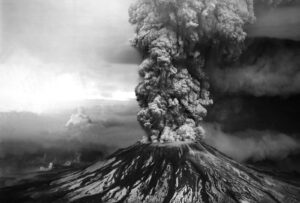
 images, as well as by a nearby pilot on May 3, 2005. A subsequent overflight revealed that much of the sitting pond within the melt hole had drained away, leaving a cauldron of notable depth. On October 23, 2024, the alert level for Mount Spurr was again raised to yellow (advisory), because of an increase in seismic activity, which is what reminds me of the Mount Saint Helens alerts.
images, as well as by a nearby pilot on May 3, 2005. A subsequent overflight revealed that much of the sitting pond within the melt hole had drained away, leaving a cauldron of notable depth. On October 23, 2024, the alert level for Mount Spurr was again raised to yellow (advisory), because of an increase in seismic activity, which is what reminds me of the Mount Saint Helens alerts.
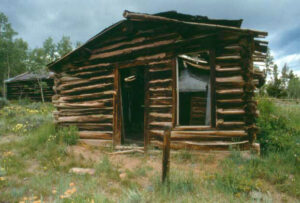
 Ghost towns dot the landscape of the United States, including Hamilton City, Wyoming, which is also known as Miner’s Delight. The town is located in Fremont County, on the southeastern tip of the Wind River Range. Miner’s Delight was in a prosperous area during the mining boom in the American West in the second half of the 19th century. It was actually a “sister city” of Atlantic City and South Pass City, however they are more well known and have fared better that Miner’s Delight. Nevertheless, a few buildings still stand today as a reminder of an era in Wyoming’s past history.
Ghost towns dot the landscape of the United States, including Hamilton City, Wyoming, which is also known as Miner’s Delight. The town is located in Fremont County, on the southeastern tip of the Wind River Range. Miner’s Delight was in a prosperous area during the mining boom in the American West in the second half of the 19th century. It was actually a “sister city” of Atlantic City and South Pass City, however they are more well known and have fared better that Miner’s Delight. Nevertheless, a few buildings still stand today as a reminder of an era in Wyoming’s past history.
Like most western mining towns, Miner’s Delight went through several boom-bust periods. With the boom-bust periods came corresponding increases and declines in its population. In 1868, gold was in the area, and by 1870, at the height of the mine’s operations. At that point, the population in Hamilton City was 75, forty of whom were miners. The original boom of mining activity “busted” from 1872 to 1874. Then, by the 1880s a new era of economic prosperity had dawned. There were smaller booms in 1907 and in 1910, and even during the Great Depression. The town was inhabited as late as 1960. By 2015, there were no residents in the town.
Jonathan Pugh founded the Miners Delight mine, which was located about a quarter mile west of the town then known as Hamilton City. The normal boom and bust periods followed, eventually leading to the mine completely shutting down in March 1882. The mine was not used again until after the turn of the 20th century. Then, two brief boom periods in 1907 and in 1910, were in relation to mining operations.
There was one famous incident involving Miner’s Delight which occurred there in March 1893. The incident was widely covered in the press at the time, which was in Cheyenne and was read throughout Wyoming. It came to be known as “the brass lock service mystery.” The postmaster of Miner’s Delight, James “Jimmy” Kime had attempted to ship eight registered letters via the Rawlins and Northwestern’s line’s Lander-to-Rawlins stagecoach to the Postmaster in Rawlins using the “brass lock service.” The Post Office’s “brass lock service” utilized canvas pouches, which were locked with brass locks. The only persons that had a key were the Postmasters along the stage line. When Kime’s pouch reached its destination in Rawlins some 120 miles to the southeast, however, the postmaster there discovered that someone had cut the pouch and stolen all the registered letters. The crime was unheard of
The US Postal inspectors investigated the matter for many months. During that time, a number of other related thefts of various valuables on the line from the locked pouches occurred. Finally, they arrested Postmaster John Gatlin of the Myersville Station near today’s Jeffrey City, Wyoming, along with his wife Stella. The couple was tried in Laramie City and the trial into the Fall of 1893. At that point, charges against John Gatlin were dropped, after Stella Gatlin confessed to stealing the items, due to what she claimed to be her illness of kleptomania. Her affidavit stated that “she had struggled for years to overcome the mania, while keeping it a secret from her husband.” On November 25, 1893, the jury found Mrs. Gatlin guilty. Two days later, she was taken to the Laramie Prison, where she was registered as Prisoner #150, the first woman to be imprisoned there after being convicted of a federal crime in Wyoming. Following a period of “good conduct” she was released early in December 1894, and following her departure, prison officials added a special new wing exclusively for women, with individual cells and a toilet.
Today, the ghost town at Miner’s Delight which eventually went by its nickname, stands as a testament to the 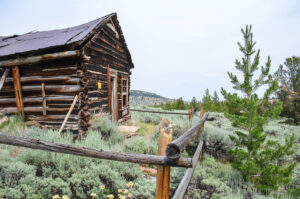
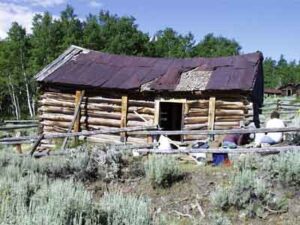 passage of time and provides historians and tourists with a peek at early Wyoming life and the gold mining culture. There are still seventeen structures, including seven cabins, one saloon, one meat house, one shop or barn, one shaft house, one pantry, one cellar, three privies, and a corral on the property. All of the buildings are constructed of logs or unfinished lumber.
passage of time and provides historians and tourists with a peek at early Wyoming life and the gold mining culture. There are still seventeen structures, including seven cabins, one saloon, one meat house, one shop or barn, one shaft house, one pantry, one cellar, three privies, and a corral on the property. All of the buildings are constructed of logs or unfinished lumber.
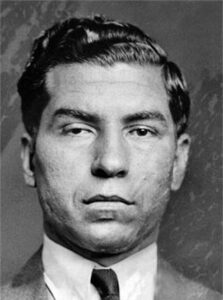
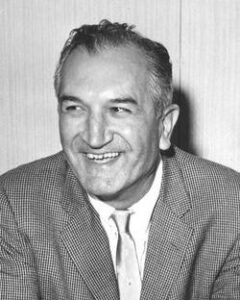 The establishment of prohibition, while originally designed to be a good thing, actually made criminals out of some people, both those who liked to have a drink and those who sold and made the alcohol. By 1931, the mob had organized. After a series of power struggles and murders, mobster Charles “Lucky” Luciano established the “Commission,” a governing body headed by five New York City crime families. Thus began four decades under the rule of the “Five Families” using tactics like loansharking, extortion, and labor union infiltration to influence and profit from a range of businesses. “They didn’t rob banks…they didn’t have to,” says Selwyn Raab, author of Five Families: The Rise, Decline, and Resurgence of America’s Most Powerful Mafia Empires. “They
The establishment of prohibition, while originally designed to be a good thing, actually made criminals out of some people, both those who liked to have a drink and those who sold and made the alcohol. By 1931, the mob had organized. After a series of power struggles and murders, mobster Charles “Lucky” Luciano established the “Commission,” a governing body headed by five New York City crime families. Thus began four decades under the rule of the “Five Families” using tactics like loansharking, extortion, and labor union infiltration to influence and profit from a range of businesses. “They didn’t rob banks…they didn’t have to,” says Selwyn Raab, author of Five Families: The Rise, Decline, and Resurgence of America’s Most Powerful Mafia Empires. “They  did all these more elegant, sophisticated crimes, because they paid more and there was less danger.” The five mob families established or basically took over a lot of different operations. They especially ran gambling and drug trafficking rings, but they also held controlling interest in construction and transportation companies.
did all these more elegant, sophisticated crimes, because they paid more and there was less danger.” The five mob families established or basically took over a lot of different operations. They especially ran gambling and drug trafficking rings, but they also held controlling interest in construction and transportation companies.
The Five Families…Genovese, Bonanno, Lucchese, Gambino and Colombo…were immigrants from Italy, particularly Sicily. Some of these were not new to the world of crime. They already had ties to Sicilian crime families, who operated according to a code of honor known as omertà…”a rule or code that prohibits speaking or divulging information about certain activities, particularly those related to criminal organizations. Omertà originated in Italy, specifically Sicily, and is often associated with the Mafia, where it represents a vow of silence regarding criminal activities and cooperation with authorities.” Because of their ties, the Five Families incorporated the concept of omertà 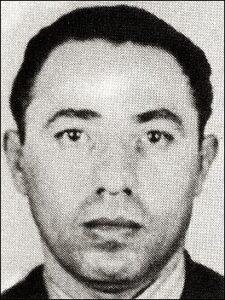
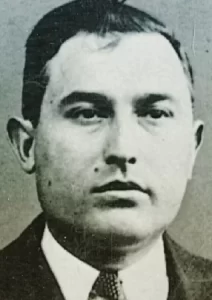 into the Commission. That effectively prohibited mobsters from ratting out members of their own family, as well as other families on the Commission…and it worked for a while.
into the Commission. That effectively prohibited mobsters from ratting out members of their own family, as well as other families on the Commission…and it worked for a while.
While the Five Families spent time in power, their influence diminished after the United States passed the 1970 Racketeer Influenced and Corrupt Organizations Act (RICO Act), which gave the government new ways to prosecute organized crime. The effectiveness of the act led mobsters to break omertà and become informants, and it even resulted in one boss flipping on his family. It is a matter of survival I guess, and apparently, while blood is thicker than water, self-preservation tops them both.
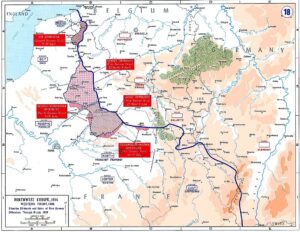
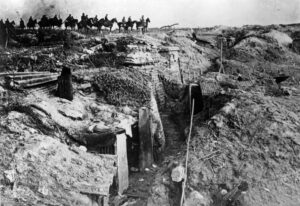 A series of German attacks along the Western Front during the First World War, beginning on March 21, 1918, known as the German Spring offensive, was also known as the Ludendorff offensive or Kaiserschlacht, which translates to Kaiser’s Battle. When the Americans entered World War I, in April 1917, the Germans knew that their days were numbered. It was decided that there was really only one way to have a chance of defeating the Allies, and that was an attack that would take place before the United States could ship soldiers across the Atlantic and fully deploy its resources. The German Army gained a temporary advantage in numbers as nearly 50 divisions had been freed by the Russian defeat and withdrawal from the war in the Treaty of Brest-Litovsk.
A series of German attacks along the Western Front during the First World War, beginning on March 21, 1918, known as the German Spring offensive, was also known as the Ludendorff offensive or Kaiserschlacht, which translates to Kaiser’s Battle. When the Americans entered World War I, in April 1917, the Germans knew that their days were numbered. It was decided that there was really only one way to have a chance of defeating the Allies, and that was an attack that would take place before the United States could ship soldiers across the Atlantic and fully deploy its resources. The German Army gained a temporary advantage in numbers as nearly 50 divisions had been freed by the Russian defeat and withdrawal from the war in the Treaty of Brest-Litovsk.
As parts of the German Spring offensive, there were four separate offensives. They were codenamed Michael, Georgette, Gneisenau, and Blücher-Yorck. The main attack was Michael, which was intended to break through the Allied lines, and outflank the British forces. The British forces held the front from the Somme River to the English Channel. The ultimate goal was to defeat the British Army. Once that was achieved, it was hoped that the French would seek armistice terms. The other offensives were secondary to Michael and were designed to divert Allied forces from the main offensive effort on the Somme. The Germans really had no clear objective established before the start of the offensives and once the operations were underway, the targets of the attacks were constantly changed, depending on the tactical situation. It was clearly not well planned.
Nevertheless, the Germans began advancing, and immediately struggled to maintain the momentum, mostly due to logistical issues. The fast-moving stormtrooper units could not carry enough food and ammunition to sustain themselves for long, and the army could not move in supplies and reinforcements fast enough to assist them. It left them wide open to failure. For their part, the Allies concentrated their main forces in the essential areas, such as the approaches to the Channel Ports and the rail junction of Amiens. The areas considered strategically worthless ground, which had been devastated by years of conflict, were left lightly defended. The danger of a German breakthrough passed within a few weeks, although related fighting continued until July.
While largely unsuccessful, the German Army, nevertheless made the deepest advances either side had made on the Western Front since 1914. They re-took much ground that they had lost in 1916–17 and took some ground that they had not yet controlled. I suppose that could have been considered at least a partial success, but despite these apparent successes, the Germans also suffered heavy casualties in return for land that was of little strategic value and hard to defend. In the end, the offensive failed to deliver a blow that could save Germany from defeat, meaning it came at such a significant cost to the Germans that it was basically a defeat. 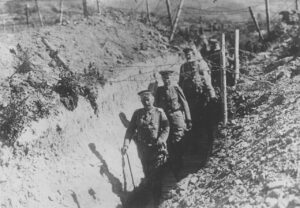
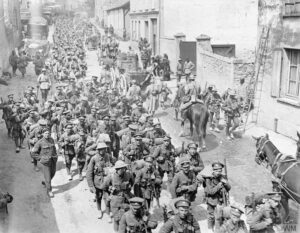 In July 1918, the Allies regained their numerical advantage with the arrival of American troops and by August, they used this and improved tactics to launch a counteroffensive. The ensuing Hundred Days Offensive resulted in the Germans losing all of the ground that they had taken in the Spring Offensive, the collapse of the Hindenburg Line, and the capitulation of Germany that November. They didn’t stand a chance.
In July 1918, the Allies regained their numerical advantage with the arrival of American troops and by August, they used this and improved tactics to launch a counteroffensive. The ensuing Hundred Days Offensive resulted in the Germans losing all of the ground that they had taken in the Spring Offensive, the collapse of the Hindenburg Line, and the capitulation of Germany that November. They didn’t stand a chance.

